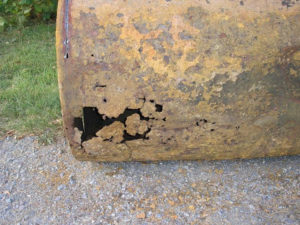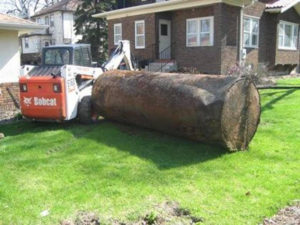Buried Oil Tank Testing

Any house that has a buried oil tank serving an existing or previously existing heating system can pose a major risk for the current homeowner or the prospective homeowner. The reason is that buried tanks can leak causing fuel oil to seep into the soil and groundwater aquifer, thus polluting the environment. If a tank is above ground or in a basement or garage, at least you can see signs of its current or immanent leaking. When it’s underground, you obviously cannot.
What causes a tank to leak?
The most common cause is the metal deteriorating due to moisture. Some tanks have faulty construction with weak spots or joints. Contrary to any common sense, some tanks are backfilled with rocks that can actually crush the tank. Even so-called “acts of God,” such as earthquakes, sinkholes or frost heaves can cause structural damage.

Other than residents on your property or the property of neighbors being subjected to drinking polluted water, or having gardens filled with oil, what is the ramification of a leaking oil tank?
It is considered by the EPA to be an environmental disaster that must be mitigated at a considerable expense, one that could reach hundreds of thousands of dollars, and the person responsible for the payment is person who holds title of the property at the time the spill is discovered. In addition, it is nearly impossible to buy any kind of meaningful insurance for a buried tank.

Even if there is no apparent buried tank and the home is older than 15 years, you may still be at risk. Despite there being an obvious tank in the basement or garage or outside under the deck, there may have previously been a buried tank that was replaced with an above ground one, yet still may be leaking. By hiring a home inspector or tank inspection company, you can stand a far better chance of finding out. An inspector will look for any signs of a previously buried tank, such as cut off copper lines in the basement that would have run from the buried tank to the boiler, or for fill and/or vent pipes in the yard that are no longer being used.
What you should do after a buried tank is discovered?
Once a buried tank is discovered, a qualified tank testing company should be called in. They have various non-invasive methods to test it, including pressure-testing and ultrasound testing. These tests generally cost in the range of $300-$600. If the tank is found to be faulty, soil samples are taken from around that area. If oil is visually identified, then they must by law, report it to the EPA who opens a case on it. The tank is generally removed from the ground and all the soil around it excavated and removed until no further oil is observed. If the oil gets into a body of water such as a stream, then more drastic measures are called for. Costs can obviously be exorbitant, and as I previously mentioned, are the sole responsibility of the person who holds title at the time the leak is discovered, not any previous owner.

